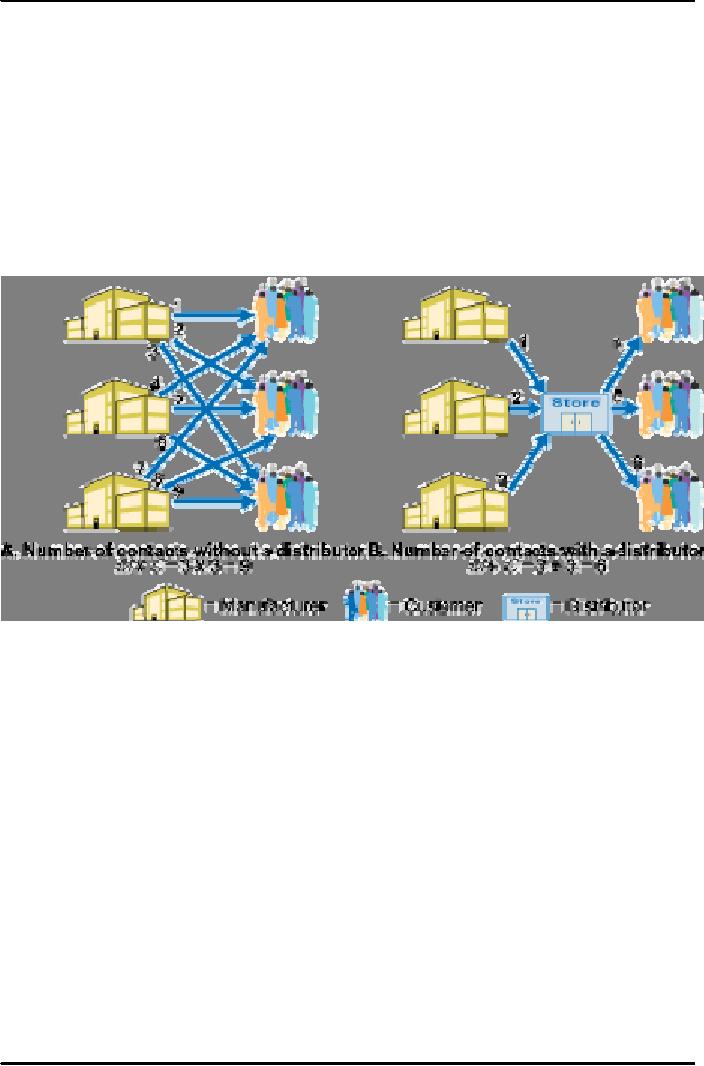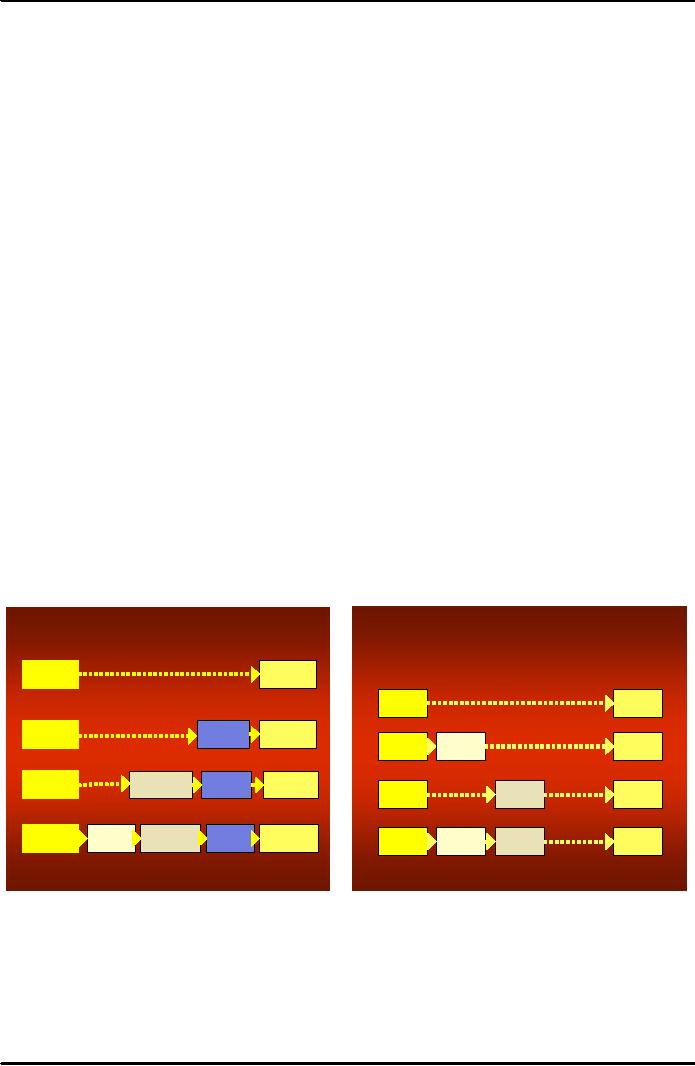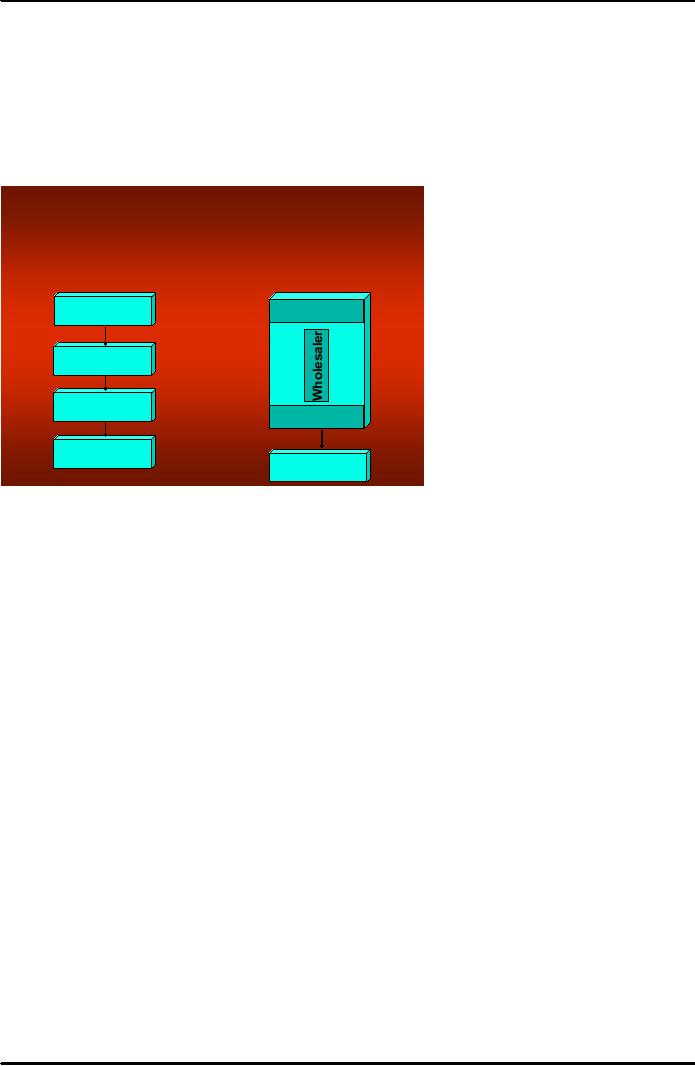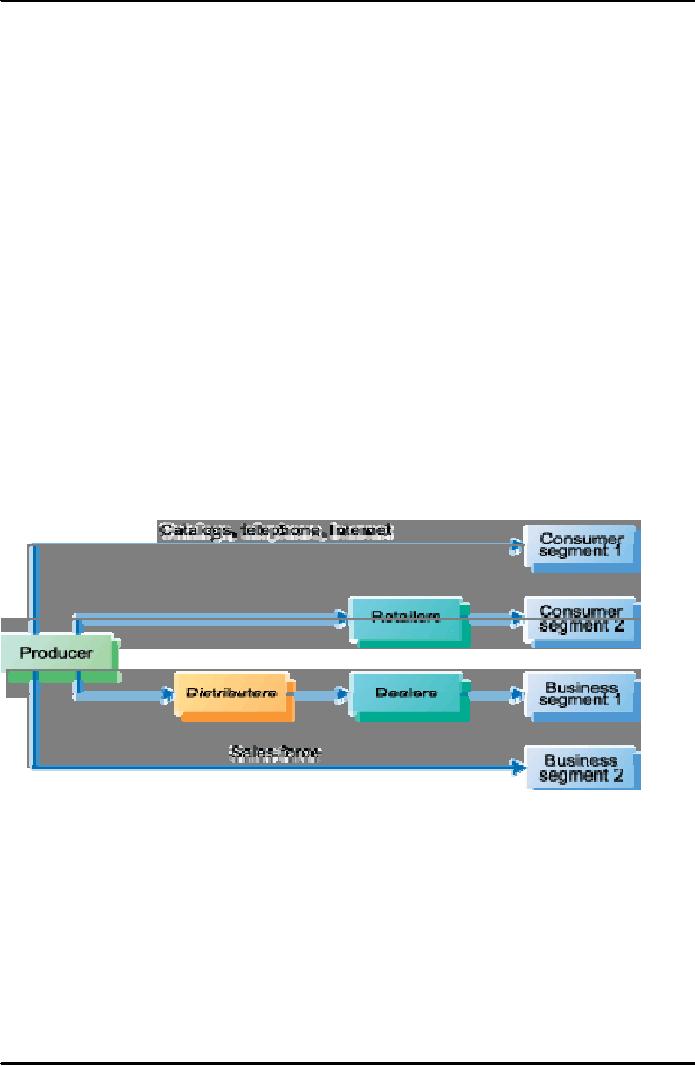 |

Principles
of Marketing MGT301
VU
margin.
The company might believe
that it will not lose
too much market share, or
that it would
lose
too much profit if it
reduced its own price. It
might decide that it should
wait and respond
when
it has more information on
the effects of the competitor's
price change. For now, it
might be
willing
to hold on to good customers, while
giving up the poorer ones to
the competitor. The
argument
against this holding strategy,
however, is that the
competitor may get stronger
and more
confident
as its sales increase and
that the company might
wait too long to
act.
If
the company decides that
effective action can and
should be taken, it might make any of
four
responses.
First, it could reduce
its price to
match the competitor's
price. It may decide that
the
market
is price sensitive and that
it would lose too much
market share to the
lower-priced
competitor.
Or it might worry that
recapturing lost market share later
would be too hard.
Cutting
the
price will reduce the
company's profits in the short
run. Some companies might
also reduce
their
product quality,
services, and marketing communications to
retain profit margins, but
this
will
ultimately hurt long-run market
share. The company should
try to maintain its quality as it
cuts
prices.
Alternatively,
the company might maintain
its price but raise
the perceived quality of its
offer. It
could
improve its communications, stressing
the relative quality of its product
over that of the
lower-price
competitor. The firm may
find it cheaper to maintain
price and spend money
to
improve
its perceived value than to cut
price and operate at a lower
margin.
Or,
the company might improve
quality and increase price,
moving its brand into a
higher-price
position.
The higher quality justifies
the higher price, which in
turn preserves the company's
higher
margins.
Or the company can hold
price on the current product
and introduce a new brand at
a
higher-price
position.
Finally,
the company might launch a
low-price "fighting
brand." Often,
one of the best
responses
is to add lower-price items to
the line or to create a
separate lower-price brand.
This is
necessary
if the particular market segment
being lost is price
sensitive and will not
respond to
arguments
of higher quality.
131

Principles
of Marketing MGT301
VU
Lesson
28
Lesson
overview and learning objectives:
Channel
design begins with assessing
customer channel-service needs and
company channel
objectives
and constraints. The company
then identifies the major
channel alternatives in terms of
the
types of intermediaries, the
number of intermediaries, and
the channel responsibilities of
each.
No
system, no matter how well
it has been planned, is without
conflict. Managing
distribution
conflict
is a necessity if quality service
and low cost is to be delivered.
Since distribution
relationships
tend to be long-term in nature,
the choice of channel partners is
very important and
should
be taken very seriously these are
the all concepts that
should be clear after today's
Lesson.
PLACE-
THE 3RD P OF MARKETING MIX.
Marketing
channel decisions are among
the most important facing
marketing
managers.
A
company's
channel decisions are linked
with every other marketing
decision. Companies
often
pay
too little attention to
their distribution channels. This
can be very damaging.
Distribution
channel
decisions often involve
long-term commitments to other
firms. There are four
major
issues
or questions that concern
distribution channels:
1).
What is the nature of
distribution channels?
2).
How do channel firms
interact and organize to do
the work of the
channel?
3).
What problems do companies face in
designing and managing
their
channels?
4).
what role does physical
distribution play in attracting and
satisfying
customers?
A.
Marketing Channel
A
set of interdependent organizations
involved in the process of making a
product or service
available
for use or consumption by
the consumer or business user. Figure
summarizes the simple
marketing
system that consists of
customer, producers that are
having some thing valuable
for
making
transactions. These transaction are made
in exchange process and creation
availability of
products
for customers. This availability is
created by using networks of distribution
channels.
Every
product and service,
Sim
ple M ark eting
whether
an automobile, a
watch,
a personal computer,
Syst
em
or
office furniture,
must
somehow
be made available
Communication
to
billions of
people.
Products
must also be made
Product/Service
available
to millions of
Producer/Seller
Consumer
Money
industrial
firms, businesses,
government
institutions, and
Feedback
other
organizations
worldwide.
Firms try to
realize
this goal through
the
creation
of distribution channels.
Channel
structure has three basic
dimensions: the length of the
channel, the intensity at
various
levels,
and the types of
intermediaries involved. Channel
intensity ranges from
intensive to
selective
to exclusive. Intensive means that
there are many
intermediaries. Selective means
that
there
are a smaller number of intermediaries.
Exclusive refers to only
one.
132

Principles
of Marketing MGT301
VU
B.
Why Are Marketing
Intermediaries Used?
Why
do producers give some of the selling
job to intermediaries? After
all, doing so means
giving
up
some control over how
and to whom the products
are sold. The use of
intermediaries results
from
their greater efficiency in making
goods available to target markets.
Through their contacts,
experience,
specialization, and scale of operation,
intermediaries usually offer
the firm more than
it
can
achieve on its own.
Figure
shows how using intermediaries
can provide economies. Figure A
shows three
manufacturers,
each using direct marketing to reach
three customers. This system
requires nine
different
contacts. Figure B shows the three
manufacturers working through one
distributor, who
contacts
the three customers. This
system requires only six contacts. In
this way,
intermediaries
reduce
the amount of work that
must be done by both producers and
consumers.
From
the economic system's point of
view, the role of marketing
intermediaries is to transform
the
assortments
of products made by producers into
the assortments wanted by consumers.
Producers
make
narrow assortments of products in
large quantities, but consumers want
broad assortments
of
products in small quantities. In the
distribution channels, intermediaries buy
large quantities
from
many producers and break
them down into the smaller
quantities and broader
assortments
wanted
by consumers. Thus, intermediaries play an
important role in matching
supply and
demand.
The
concept of distribution channels is not
limited to the distribution of tangible
products.
Producers
of services and ideas also
face the problem of making
their output available to
target
markets.
In the private sector, retail stores,
hotels, banks, and other
service providers take
great
care
to make their services
conveniently available to target
customers. In the public sector,
service
organizations
and agencies develop "educational
distribution systems" and
"health care delivery
systems"
for reaching sometimes
widely dispersed populations.
Hospitals must be located to
serve
various
patient populations, and
schools must be located
close to the children who
need to be
taught.
Communities must locate
their fire stations to provide rapid
response to fires and
polling
stations
must be placed where people
can vote
conveniently.
133

Principles
of Marketing MGT301
VU
C.
Distribution Channel Functions
The
distribution channel moves
goods and services from
producers to consumers. It overcomes
the
major time, place, and
possession gaps that
separate goods and services
from those who would
use
them. Members of the marketing channel
perform many key
functions:
�
Information:
gathering
and distributing marketing research
and intelligence information
about
actors and forces in the marketing
environment needed for
planning and aiding
exchange.
�
Promotion:
developing
and spreading persuasive
communications about an
offer.
�
Contact:
finding
and communicating with prospective
buyers.
�
Matching:
shaping
and fitting the offer to
the buyer's needs, including activities
such as
manufacturing,
grading, assembling, and
packaging.
�
Negotiation:
reaching
an agreement on price and
other terms of the offer so
that ownership
or
possession can be transferred.
Others
help to fulfill the completed
transactions:
�
Physical
distribution: transporting
and storing goods.
�
Financing:
acquiring
and using funds to cover the
costs of the channel
work.
�
Risk
taking: assuming
the risks of carrying out
the channel work.
The
question is not whether
these
functions need to be performed--they
must be--but rather
who
will
perform them. To the extent
that the manufacturer
performs these functions, its
costs go up
and
its prices have to be higher. At
the same time, when
some of these functions are
shifted to
intermediaries,
the producer's costs and
prices may be lower, but
the intermediaries must
charge
more
to cover the costs of their
work. In dividing the work
of the channel, the various
functions
should
be assigned to the channel
members who can perform
them most efficiently and
effectively
to
provide satisfactory assortments of goods
to target consumers.
D.
Number of Channel Levels
Distribution
channels can be described by the
number of channel levels
involved. Each layer
of
marketing
intermediaries that performs
some work in bringing the
product and its
ownership
closer
to the final buyer is a
channel level.
Because
Figure
A
Figure
B
Producer
Consumer
Business
Producer
User
Producer
Retailer
Consumer
Agent/
Business
Producer
Broker
User
Producer
Wholesaler
Retailer
Consumer
Business
Producer
Wholesaler
User
Agent/
Agent/
Business
Producer
Wholesaler
Retailer Consumer
Producer
Wholesaler
Broker
Broker
User
the
producer and the final
consumer both perform some
work, they are part of every
channel. We
use
the number of intermediary
levels to indicate the
length of a channel. Figure A shows
several
consumer
distribution channels of different
lengths.
Channel
1, called a direct marketing channel, has
no intermediary levels. It consists of a
company
selling
directly to consumers. The remaining channels in
Figure A are indirect marketing
channels.
Channel
2 contains one intermediary level. In consumer
markets, this level is
typically a retailer.
134

Principles
of Marketing MGT301
VU
For
example, the makers of televisions,
cameras, tires, furniture,
major appliances, and many
other
products
sell their goods directly to
large retailers which then
sell the goods to final
consumers.
Channel
3 contains two intermediary levels, a
wholesaler and a retailer. This channel
is often used
by
small manufacturers of food, drugs,
hardware, and other products.
Channel 4 contains three
intermediary
levels. In the meatpacking
industry, for example, jobbers
buy from wholesalers
and
sell
to smaller retailers who generally are
not served by larger
wholesalers. Distribution channels
with
even more levels are
sometimes found, but less
often. From the producer's
point of view, a
greater
number of levels means less
control and greater channel
complexity.
Figure
B shows some common business
distribution channels. The business
marketer can use its
own
sales force to sell directly
to business customers. It can also
sell to industrial distributors,
who
in
turn sell to business customers. It
can sell through
manufacturer's representatives or its
own
sales
branches to business customers, or it can
use these representatives
and branches to sell
through
industrial distributors. Thus,
business markets commonly
include multilevel
distribution
channels.
All
of the institutions in the
channel are connected by several
types of flows. These
include the
physical
flow of products, the flow
of ownership, the payment
flow, the information flow,
and the
promotion
flow. These flows can
make even channels with only
one or a few levels very
complex.
E.
Channel Behavior and
Organization
Distribution
channels are more than
simple collections of firms tied
together by various flows.
They
are complex behavioral systems in
which people and companies
interact to accomplish
individual,
company, and channel goals.
Some channel systems consist
only of informal
interactions
among loosely organized firms;
others consist of formal
interactions guided by
strong
organizational
structures. Moreover, channel
systems do not stand
still--new types of
intermediaries
emerge and whole new
channel systems evolve. Here
we look at channel
behavior
and
at how members organize to do
the work of the
channel.
Channel
Behavior
A
distribution channel consists of
firms that have banded
together for their common
good. Each
channel
member is dependent on the others. Each
channel member plays a role in
the channel and
specializes
in performing one or more functions.
The channel will be most
effective when each
member
is assigned the tasks it can
do best.
Ideally,
because the success of
individual channel members
depends on overall channel
success, all
channel
firms should work together
smoothly. They should understand
and accept their
roles,
coordinate
their goals and activities,
and cooperate to attain overall
channel goals. By cooperating,
they
can more effectively sense,
serve, and satisfy the
target market.
However,
individual channel members rarely
take such a broad view. They
are usually more
concerned
with their own short-run
goals and their dealings
with those firms closest to
them in the
channel.
Cooperating to achieve overall channel
goals sometimes means giving
up individual
company
goals. Although channel
members are dependent on one another,
they often act alone
in
their
own short-run best
interests. They often
disagree on the roles each
should play--on who
should
do what and for what
rewards. Such disagreements
over goals and roles
generate channel
conflict.
Horizontal
conflict occurs among firms at the
same level of the channel.
Vertical conflict,
conflicts
between
different levels of the same
channel, is even more
common. Some conflict in the
channel
takes
the form of healthy
competition. Such competition
can be good for the
channel--without it,
the
channel could become passive
and non innovative. But
sometimes conflict can
damage the
channel.
For the channel as a whole
to perform well, each
channel member's role must
be specified
and
channel conflict must be
managed. Cooperation, role assignment,
and conflict management
in
the
channel are attained through
strong channel leadership.
The channel will perform
better if it
includes
a firm, agency, or mechanism
that has the power to
assign roles and manage
conflict.
135

Principles
of Marketing MGT301
VU
F.
Vertical Marketing
Systems
Historically,
distribution channels have been
loose collections of independent
companies, each
showing
little concern for overall
channel performance. These conventional
distribution channels
have
lacked strong leadership and
have been troubled by
damaging conflict and poor
performance.
One
of the biggest recent channel
developments has been the
vertical marketing systems that
have
emerged
to challenge conventional marketing channels. Figure
contrasts the two types of
channel
arrangements.
A conventional distribution channel
consists of one or more
independent
producers,
wholesalers, and retailers. Each is a
separate business seeking to
maximize its own
profits,
even at the expense
of
Vertical
Conventional
profits
for the system as a
whole.
M
arketing
Marketing
No
channel member has
much
Channel
control
over the other
members,
Channel
and
no formal means exists
for
assigning
roles and
resolving
channel
conflict. In contrast, a
Manufacturer
Manufacturer
Vertical
Marketing System
(VMS)
consists
of producers, wholesalers,
Wholesaler
and
retailers acting as a
unified
system.
One channel member
owns
the
others, has contracts with
them,
Retailer
Retailer
or
wields so much power that
they
must
all cooperate. The VMS
can be
Consumer
dominated
by the producer,
Consumer
wholesaler,
or retailer. Vertical
marketing
systems came into being to
control channel behavior and
manage channel
conflict.
We
look now at three major
types of VMSs: corporate,
contractual, and
administered.
Each
uses a
different
means for setting up leadership
and power in the channel. We
now take a closer look
at
each
type of VMS.
a.
Corporate VMS
A
corporate VMS combines successive
stages of production and
distribution under
single
ownership.
Coordination and conflict
management are attained
through regular organizational
channels.
b.
Contractual VMS
A
contractual VMS consists of independent
firms at different levels of
production and
distribution
who
joins together through contracts to
obtain more economies or
sales impact than each
could
achieve
alone. Coordination and
conflict management are
attained through contractual
agreements
among
channel members. There are
three types of contractual
VMSs: wholesaler-sponsored
voluntary
chains, retailer cooperatives, and
franchise organizations.
In
wholesaler-sponsored
voluntary chains, wholesalers
organize voluntary chains of independent
retailers
to
help them compete with
large chain organizations. The wholesaler
develops a program in which
independent
retailers standardize their selling
practices and achieve buying
economies that let
the
group
compete effectively with chain
organizations. In retailer
cooperatives, retailers
organize a new,
jointly
owned business to carry on wholesaling
and possibly production. Members buy
most of
their
goods through the retailer
co-op and plan their
advertising jointly. Profits are
passed back to
members
in proportion to their purchases. In
franchise organizations, a channel member called
a
franchiser
links
several stages in the
production-distribution process. There
are three forms of
franchises.
The first form is the
manufacturer-sponsored
retailer franchise system, as
found in the
automobile
industry. The second type of
franchise is the manufacturer-sponsored
wholesaler franchise
system,
as
found in the soft drink
industry.. The third franchise
form is the service-firm-sponsored
retailer
franchise
system, in
which a service firm
licenses a system of retailers to
bring its service to
consumers.
The fact that most
consumers cannot tell the
difference between contractual
and
136

Principles
of Marketing MGT301
VU
corporate
VMSs shows how successfully
the contractual organizations compete
with corporate
chains.
c.
Administered VMS
An
administered VMS coordinates
successive stages of production
and distribution, not
through
common
ownership or contractual ties
but through the size
and power of one of the
parties. In an
administered
VMS, leadership
is assumed by one or a few dominant
channel members.
Manufacturers
of a top brand can obtain
strong trade cooperation and
support from
resellers.
G.
Horizontal Marketing
Systems
Another
channel development is the
horizontal marketing system, in which
two or more
companies
at one level join together to
follow a new marketing opportunity. By
working together,
companies
can combine their capital,
production capabilities, or marketing
resources to accomplish
more
than any one company could
alone. Companies might join
forces with competitors or
non-
competitors.
They might work with
each other on a temporary or
permanent basis, or they
may
create
a separate company. Such
channel arrangements also
work well globally.
H.
Hybrid Marketing
Systems
In
the past, many companies
used a single channel to
sell to a single market or market
segment.
Today,
with the proliferation of customer
segments and channel
possibilities, more and
more
companies
have adopted multichannel
distribution systems--often
called hybrid marketing channels.
Such
multichannel marketing occurs when a
single firm sets up two or
more marketing channels to
reach
one or more customer segments. The
use of hybrid channel
systems has increased greatly
in
recent
years.
Figure
shows a hybrid channel. In
the figure, the producer
sells directly to consumer segment
1
using
direct-mail catalogs and telemarketing
and reaches consumer segment
2 through retailers. It
sells
indirectly to business segment 1
through distributors and
dealers and to business
segment 2
through
its own sales force.
Hybrid
Marketing Channel
Hybrid
channels offer many advantages to
companies facing large and
complex markets. With
each
new
channel, the company expands
its sales and market coverage
and gains opportunities to
tailor
its
products and services to the
specific needs of diverse
customer segments. But such
hybrid
channel
systems are harder to control,
and they generate conflict
as more channels compete
for
customers
and sales
I.
Channel Design Decisions
We
now look at several channel
decisions manufacturers face. In
designing marketing channels,
manufacturers
struggle between what is ideal
and what is practical. A new
firm with limited
capital
usually
starts by selling in a limited market
area. Deciding on the best
channels
might not be a
problem:
The problem might simply be
how to convince one or a few
good intermediaries to
handle
the line.
137

Principles
of Marketing MGT301
VU
If
successful, the new firm
might branch out to new
markets through the existing
intermediaries.
In
smaller markets, the firm
might sell directly to
retailers; in larger markets, it
might sell through
distributors.
In one part of the country, it
might grant exclusive franchises; in
another, it might
sell
through
all available outlets. In
this way, channel systems
often evolve to meet
market
opportunities
and conditions. However, for
maximum effectiveness, channel
analysis and decision
making
should be more purposeful. Designing a
channel system calls for
analyzing consumer
service
needs, setting channel objectives and
constraints, identifying major channel
alternatives,
and
evaluating them.
a.
Analyzing Consumer Service
Needs
As
noted previously, marketing channels can
be thought of as customer
value delivery systems in
which
each
channel member adds value for
the customer. Thus,
designing the distribution
channel starts
with
finding out what targeted
consumers want from the
channel. Do consumers want to buy
from
nearby
locations or are they willing to
travel to more distant centralized
locations? Would they
rather
buy in person, over the
phone, through the mail, or via
the Internet? Do they value
breadth
of
assortment or do they prefer
specialization? Do consumers want
many add-on services
(delivery,
credit, repairs, installation) or will
they obtain these elsewhere?
The faster the
delivery,
the
greater the assortment provided,
and the more add-on services
supplied, the greater
the
channel's
service level.
But
providing the fastest
delivery, greatest assortment, and
most services may not be
possible or
practical.
The company and its channel
members may not have
the resources or skills needed
to
provide
all the desired services.
Also, providing higher
levels of service results in higher
costs for
the
channel and higher prices
for consumers. The company
must balance consumer service
needs
not
only against the feasibility
and costs of meeting these
needs but also against
customer price
preferences.
The success of off-price and
discount retailing shows that
consumers are often
willing
to
accept lower service levels
if this means lower
prices.
b.
Setting Channel Objectives and
Constraints
Channel
objectives should be stated in terms of
the desired service level of
target consumers.
Usually,
a company can identify
several segments wanting
different levels of channel
service. The
company
should decide which segments
to serve and the best
channels to use in each case. In
each
segment,
the company wants to minimize
the total channel cost of
meeting customer service
requirements.
The
company's channel objectives are also
influenced by the nature of
the company, its
products,
marketing
intermediaries, competitors, and
the environment. For
example, the company's size
and
financial
situation determine which marketing
functions it can handle itself
and which it must
give
to
intermediaries. Companies selling
perishable products may require
more direct marketing to
avoid
delays and too much
handling. In some cases, a
company may want to compete
in or near
the
same outlets that carry
competitors' products. In other
cases, producers may avoid
the
channels
used by competitors. Finally,
environmental factors such as economic conditions
and
legal
constraints may affect
channel objectives and design.
For example, in a depressed
economy,
producers
want to distribute their
goods in the most economical
way, using shorter channels
and
dropping
unneeded services that add
to the final price of the
goods.
c.
Identifying Major Alternatives
When
the company has defined its
channel objectives, it should next
identify its major
channel
alternatives
in terms of types
of
intermediaries, the number
of
intermediaries, and the
responsibilities
of
each
channel member.
d.
Types of Intermediaries
A
firm should identify the
types of channel members
available to carry out its channel
work. For
example,
suppose a manufacturer of test
equipment has developed an
audio device that
detects
poor
mechanical connections in machines
with moving parts. Company
executives think this
product
would have a market in all industries in
which electric, combustion, or steam
engines are
made
or used. The company's current
sales force is small, and
the problem is how best to
reach
138

Principles
of Marketing MGT301
VU
these
different industries. The following
channel alternatives might emerge
from management
discussion:
Company
sales force: Expand the
company's direct sales force. Assign
outside salespeople to
territories
and have them contact
all prospects in the area or
develop separate company sales
forces
for
different industries. Or, add an
inside telesales operation in
which telephone salespeople
handles
small
or
midsize
companies.
Manufacturer's
agency: Hire manufacturer's
agents--independent firms whose
sales forces handle
related
products from many
companies--in different regions or
industries to sell the new
test
equipment.
Industrial
distributors: Find distributors in
the different regions or industries
who will buy
and
carry
the new line. Give
them exclusive distribution, good
margins, product training,
and
promotional
support.
e.
Number of Marketing
Intermediaries
Companies
must also determine the
number of channel members to
use at each level.
Three
strategies
are available: intensive
distribution, exclusive distribution, and
selective distribution.
Producers
of convenience products and common
raw materials typically seek
intensive
distribution--a
strategy in which they stock
their products in as many
outlets as possible.
These
goods
must be available where and
when consumers want them.
For example, toothpaste, candy,
and
other similar items are sold in
millions of outlets to provide
maximum brand exposure
and
consumer
convenience. By contrast, some producers
purposely limit the number
of intermediaries
handling
their products. The extreme
form of this practice is exclusive
distribution, in which
the
producer
gives only a limited number
of dealers the exclusive right to
distribute its products in
their
territories. Exclusive distribution is
often found in the
distribution of new automobiles
and
prestige
women's clothing. Exclusive distribution
also enhances the car's
image and allows for
higher
markups.
Between
intensive and exclusive distribution
lies selective distribution--the
use of more than one,
but
fewer than all, of the
intermediaries who are
willing to carry a company's products.
Most
television,
furniture, and small-appliance
brands are distributed in
this manner. They can
develop
good
working relationships with selected
channel members and expect a
better-than-average selling
effort.
Selective distribution gives producers
good market coverage with
more control and less
cost
than
does intensive
distribution.
J.
Channel Management Decisions
Once
the company has reviewed its
channel alternatives and decided on
the best channel design,
it
must
implement and manage the
chosen channel. Channel
management calls for
selecting and
motivating
individual channel members
and evaluating their performance
over time.
a.
Selecting Channel Members
Producers
vary in their ability to
attract qualified marketing intermediaries.
Some producers have
no
trouble signing up channel members. In
some cases, the promise of exclusive or
selective
distribution
for a desirable product will
draw plenty of
applicants.
At
the other extreme are producers
who have to work hard to
line up enough qualified
intermediaries..
When
selecting intermediaries, the
company should determine what
characteristics distinguish the
better
ones. It will want to
evaluate each channel
member's years in business,
other lines carried,
growth
and profit record, cooperativeness,
and reputation. If the
intermediaries are sales
agents,
the
company will want to
evaluate the number and
character of other lines
carried and the size
and
quality
of the sales force. If the
intermediary is a retail store that wants
exclusive or selective
distribution,
the company will want to
evaluate the store's customers,
location, and future
growth
potential.
139

Principles
of Marketing MGT301
VU
b.
Motivating Channel Members
Once
selected, channel members
must be motivated continuously to do
their best. The
company
must
sell not only through
the
intermediaries but to
them.
Most companies see their
intermediaries
as
first-line customers. Some use
the carrot-and-stick approach: At
times they offer positive
motivators
such as higher margins, special
deals, premiums, cooperative advertising
allowances,
display
allowances, and sales
contests. At other times
they use negative
motivators,
such as
threatening
to reduce margins, to slow
down delivery, or to end the
relationship altogether. A
producer
using this approach usually
has not done a good job of
studying the needs,
problems,
strengths,
and weaknesses of its
distributors.
More
advanced companies try to
forge long-term partnerships with
their distributors to create
a
marketing
system that meets the
needs of both the
manufacturer and
the
distributors. In managing
its
channels, a company must convince
distributors that they can
make their money by being
part
of
an advanced marketing system.
c.
Evaluating Channel Members
The
producer must regularly
check the channel member's
performance against standards such
as
sales
quotas, average inventory
levels, customer delivery time,
and treatment of damaged and
lost
goods,
cooperation in company promotion and
training programs, and
services to the
customer.
The
company should recognize and
reward intermediaries who are
performing well. Those
who
are
performing poorly should be
assisted or, as a last resort,
replaced. A company may
periodically
"requalify"
its intermediaries and prune
the weaker ones.
Finally,
manufacturers need to be sensitive to
their dealers. Those who
treat their dealers
lightly
risk
not only losing their
support but also causing
some legal problems.
Changing
Channel Organization
Changes
in technology and the explosive
growth of direct and online
marketing are having
a
profound
impact on the nature and
design of marketing channels. One major
trend is toward
disintermediation--a
big term with a
clear message and
important
consequences.
Disintermediation
means that more and
more, product and service
producers are bypassing
intermediaries
and going directly to final
buyers, or that radically new types of
channel
intermediaries
are emerging to displace
traditional ones.
Thus,
in many industries, traditional
intermediaries are dropping by
the wayside.
Disintermediation
presents
problems and opportunities for
both producers and intermediaries. To
avoid being swept
aside,
traditional intermediaries must
find new ways to add value
in the supply chain. To remain
competitive,
product and service producers
must develop new channel
opportunities, such as
Internet
and other direct channels. However,
developing these new channels often
brings them
into
direct competition with their
established channels, resulting in
conflict. To ease this
problem,
companies
often look for ways to
make going direct a plus for
both the company and its
channel
partners:
However,
although this compromise system
reduces conflicts, it also
creates inefficiencies.
140
Table of Contents:
- PRINCIPLES OF MARKETING:Introduction of Marketing, How is Marketing Done?
- ROAD MAP:UNDERSTANDING MARKETING AND MARKETING PROCESS
- MARKETING FUNCTIONS:CUSTOMER RELATIONSHIP MANAGEMENT
- MARKETING IN HISTORICAL PERSPECTIVE AND EVOLUTION OF MARKETING:End of the Mass Market
- MARKETING CHALLENGES IN THE 21st CENTURY:Connections with Customers
- STRATEGIC PLANNING AND MARKETING PROCESS:Setting Company Objectives and Goals
- PORTFOLIO ANALYSIS:MARKETING PROCESS,Marketing Strategy Planning Process
- MARKETING PROCESS:Analyzing marketing opportunities, Contents of Marketing Plan
- MARKETING ENVIRONMENT:The Company’s Microenvironment, Customers
- MARKETING MACRO ENVIRONMENT:Demographic Environment, Cultural Environment
- ANALYZING MARKETING OPPORTUNITIES AND DEVELOPING STRATEGIES:MIS, Marketing Research
- THE MARKETING RESEARCH PROCESS:Developing the Research Plan, Research Approaches
- THE MARKETING RESEARCH PROCESS (Continued):CONSUMER MARKET
- CONSUMER BUYING BEHAVIOR:Model of consumer behavior, Cultural Factors
- CONSUMER BUYING BEHAVIOR (CONTINUED):Personal Factors, Psychological Factors
- BUSINESS MARKETS AND BUYING BEHAVIOR:Market structure and demand
- MARKET SEGMENTATION:Steps in Target Marketing, Mass Marketing
- MARKET SEGMENTATION (CONTINUED):Market Targeting, How Many Differences to Promote
- Product:Marketing Mix, Levels of Product and Services, Consumer Products
- PRODUCT:Individual product decisions, Product Attributes, Branding
- PRODUCT:NEW PRODUCT DEVELOPMENT PROCESS, Idea generation, Test Marketing
- NEW PRODUCT DEVELOPMENT:PRODUCT LIFE- CYCLE STAGES AND STRATEGIES
- KEY TERMS:New-product development, Idea generation, Product development
- Price the 2nd P of Marketing Mix:Marketing Objectives, Costs, The Market and Demand
- PRICE THE 2ND P OF MARKETING MIX:General Pricing Approaches, Fixed Cost
- PRICE THE 2ND P OF MARKETING MIX:Discount and Allowance Pricing, Segmented Pricing
- PRICE THE 2ND P OF MARKETING MIX:Price Changes, Initiating Price Increases
- PLACE- THE 3RD P OF MARKETING MIX:Marketing Channel, Channel Behavior
- LOGISTIC MANAGEMENT:Push Versus Pull Strategy, Goals of the Logistics System
- RETAILING AND WHOLESALING:Customer Service, Product Line, Discount Stores
- KEY TERMS:Distribution channel, Franchise organization, Distribution center
- PROMOTION THE 4TH P OF MARKETING MIX:Integrated Marketing Communications
- ADVERTISING:The Five M’s of Advertising, Advertising decisions
- ADVERTISING:SALES PROMOTION, Evaluating Advertising, Sales Promotion
- PERSONAL SELLING:The Role of the Sales Force, Builds Relationships
- SALES FORCE MANAGEMENT:Managing the Sales Force, Compensating Salespeople
- SALES FORCE MANAGEMENT:DIRECT MARKETING, Forms of Direct Marketing
- DIRECT MARKETING:PUBLIC RELATIONS, Major Public Relations Decisions
- KEY TERMS:Public relations, Advertising, Catalog Marketing
- CREATING COMPETITIVE ADVANTAGE:Competitor Analysis, Competitive Strategies
- GLOBAL MARKETING:International Trade System, Economic Environment
- E-MARKETING:Internet Marketing, Electronic Commerce, Basic-Forms
- MARKETING AND SOCIETY:Social Criticisms of Marketing, Marketing Ethics
- MARKETING:BCG MATRIX, CONSUMER BEHAVIOR, PRODUCT AND SERVICES
- A NEW PRODUCT DEVELOPMENT:PRICING STRATEGIES, GLOBAL MARKET PLACE